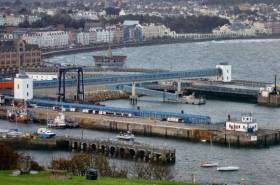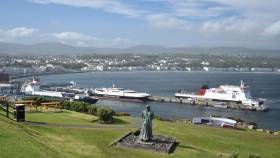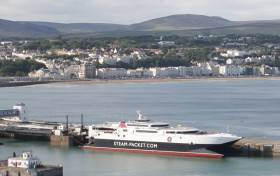Displaying items by tag: SteamPacket
'Serious concerns' have been raised by the Isle of Man Steam Packet in regards to the effect of growing windfarms in the Irish Sea.
As 3FM reports, the ferry operator has concerns following proposals for the windfarm of 'Morecambe and Morgan' which would be based in the Irish Sea.
The proposed windfarm would be in an area south-east of the Island along the route taken by the company's fast-ferry operating between Douglas and Liverpool. The 69 nautical mile route links the Manx capital to Merseyside where a new terminal is currently under construction.
Across the Island, leaflets have been posted asking for views expressed from the public. In addition a consultation process has been launched online which gives details of consultation venues and dates aswell as for pop-events noting an online event is scheduled for 10 November.
The Steam Packet posted on its website to say that it's 'supportive of sustainability and renewable energy' - and 'broadly speaking' the company supports initiatives to tackle energy challgenges.
More here on this renewable energy project story.
Douglas Harbour Planning Application An 'Important Development'
A planning application submitted by the Isle of Man Government's Department of Infrastructure (DoI) to improve Douglas Harbour is an important development according to the Minister.
It's for a marine dolphin and footbridge on King Edward VIII pier, and would include installing a mooring platform and mooring bollard.
Additional work not included in the plans will also be carried out which doesn't need approval by the planning board.
Chris Thomas says the work will improve the harbour in bad weather especially, and explains what marine dolphins are: (according to Manx Radio's audio clip that includes reference to newbuild ferry Manxman due in 2023).
The Minister added that the application has been put together in consultation with the Isle of Man Steam Packet, and more details will be given to Tynwald members and the public in September.
The Steam Packet has declined our invitation to comment.
Isle of Man Department Submits Plans to Extend Douglas Harbour's King Edward VIII Pier
The Isle of Man Government's Department of Infrastructure wants to build a dolphin and footbridge in Douglas Harbour.
As Manx Radio reports, plans have been published to extend one of the harbour's piers used by ferry operator, the IOM Steam Packet Company.
The DoI has submitted a planning application for a marine dolphin and footbridge on King Edward VIII Pier.
The application says the scheme would include installing a mooring platform and bollard, as well as additional work not included in the plans as it would not need approval by the planning board.
The site is in a high-risk flood zone, but the department says it has not carried out a flood risk assessment as the structure will be founded in the seabed.
Excursionists Enjoy Round Isle of Man Cruise
Around 300 passengers enjoyed spectacular views of the Isle of Man’s coastline on this year’s Ben-my-Chree round-the-island cruise which was held last Saturday following Midsummer's day.
The ropax which the IOM Steam-Packet operates on the route to Heysham, England, departed Douglas at 19:00hrs on the special cruise which first went across the bay towards Onchan Head, swinging back around and continuing south. From there the cruise which included a meal as part of the fare offered further stunning views of Port Erin Bay followed by Peel and its castle.
The fine evening meant that the crew were able to open up Deck 5 to allow passengers to get a great look at the coastline from the vehicle deck. There was also a refurbished motorised horse tram on the deck which made a great vantage point and photo opportunity.
It was an enjoyable evening for all with stunning coastal views, delicious food and musical entertainment from Douglas Town Band’s oompah act, Baron Otto's Blaskapelle, who performed several sets in the ship’s bar throughout the cruise.
Manx Minister Wants More Tourists to Fill Sailings
#ferries - Manx minister for Enterprise wants to see fewer sailings operating at low capacity.
According to Manx Radio, the 2018 Isle of Man Passenger Survey results show the number of people travelling by sea dropped by 6% last year.
Tynwald (the island's Parliament) recently approved a plan for the future of the Isle of Man Steam Packet Company, after the government purchased the ferry operator last year.
Laurence Skelly is keen to attract more tourists to fill the empty seats.
To listen and watch the Minister speak on the radio station click the link here.
Manx Fastcraft Conducts Berthing Trials in Dublin Port Against Backdrop of Capacity Restrictions & Brexit
#ferries - The Isle of Man Steam Packet's fastcraft Manannan arrived to Dublin Port yesterday to carry out berthing trials against the backdrop of port capacity restrictions and challenges posed by Brexit, writes Jehan Ashmore.
Prior to entering the port by the 850 passenger/200 vehicle Manannan, a routine yet busy succession of ferry and ro-ro freight ships departed through Dublin Bay. They were all bound for the UK to the ports of Holyhead, Liverpool and Heysham.
The Steam-Packet confirmed to Afloat.ie that the Manannan conducted the berthing trials on two berths to determine if either could be used as a back-up in the event access to the normally used berth (at Terminal No.1, the port's busiest) should it be restricted or out of action.
Acquired by the Manx Government last year, the ferry operator is set to resume seasonal service linking Douglas and Dublin on Thursday, 18 April in advance of the Easter Bank Holiday weekend. The 96m Manannan which has operated on the Irish Sea since 2009 is however first scheduled to resume on another seasonal service this week between Douglas and Belfast when sailings start on Sunday, 7 April.
Afloat monitored Manannan carry out the first berthing trial in Dublin where Stena Line operate out of Terminal 2. The terminal is located adjacent to where rivals Irish Ferries use the port's busiest ferry facility at Terminal 1. Also berthed there was another fastcraft, Dublin Swift which during the St. Patrick's Festival began a second summer season for Irish Ferries on the core Irish Sea route to Holyhead in tandem with Ulysses and the chartered-in ropax Epsilon.
In addition at Terminal 1 last month saw the introduction of Irish Ferries much anticipated new giant cruiseferry W.B. Yeats (onto the Dublin-France service) which has doubled in the number sailings by up to 4 weekly on the continental link to Cherbourg. Up to then Epsilon served this route and Oscar Wilde since September, following the apparent closure of Rosslare based routes to France (see below).
W.B. Yeats which at 51,388grt is the largest ferry ever to operate out of Ireland and also brings a Brexit related boost to capacity on the direct link to mainland Europe though seemingly at the expense of Rosslare Europort and the south-east region. As in December, Irish Ferries announced they would unlikely resume services to France in 2019 but added they would keep this situation under review. In the meantime the 1987 built Oscar Wilde remains in dry-dock at Harland & Wolff, Belfast, so what beckons for the future of this cruiseferry?
As widely reported in the media, Dublin Port has imposed restrictions by placing a limit on the number of cruiseships calling to the capital. This is due to Brexit which will force the port to handle increased amounts of freight and cargo directly from mainland Europe, as distinct to depending on services that make up the UK land-bridge to mainland Europe. This will lead to more considered allocation of berths and in particular at Alexandra Basin where a major redevelopment is ongoing as part of the port's Masterplan.
The second of Manannan's Dublin berthing trials took place upriver at Ocean Pier (notably not a ferry passenger terminal). Located here at this same berth linkspan in Alexandra Basin (East) is where the latest Brexit-Buster the newbuild ro-ro freight ship Laureline made a maiden call last week. The giant ship is among the operator, CLnD's fleet including Celine but docks at the adjacent Alexandra Basin from also where direct services run to Zeebrugge in Belgium and Europe's largest port, Rotterdam in The Netherlands.
Laureline which is around the same size in gross tonnage terms of W.B. Yeats, is to return for only the second time to Dublin Port today with an arrival around lunch-hour.
Planned £30m Ferry Terminal in Liverpool for Isle of Man Service - Images Unveiled
#FerryNews- The new ferry terminal planned for Liverpool the IOMToday reports have included images that have been unveiled.
The pictures have been released ahead of a public display in Liverpool this week. A planning application is due to be submitted next month.
The images show that the new building would be glass fronted with a steel frame, with passengers welcomed in English and Manx above the main door.
Infrastructure Minister Ray Harmer MHK said: ’The proposed terminal has been designed to combine a high standard of civil engineering with a high quality building.’
Car passengers will enter from the road currently under construction as part of Liverpool’s city centre connection project, with bus and taxi spaces provided.
Foot passengers will be able to enter along the access bridge, which is at the rear of the Alexandra Tower.
Freight vehicles will wait to board boats in a designated area next to the river.
For more on the development. click here.
#FerryNews - IOM Today reports of a newly-formed lobby group that says it has ’serious concerns’ about the ’strategic vulnerablility’ of Douglas port.
Isle of Man Maritime Ltd, a not-for-profit company which has replaced the Isle of Man Shipping Association, points out the harbour is too small to handle the larger roll-on, roll-off vessels that are now the norm.
And it says there is no contingency plan should there be a serious incident in the harbour which blocks it to other sea traffic.
It issued the statement after Tynwald last month backed an £80m strategy to redevelop Douglas harbour and attract more cruise liners to the island.
The Shipping Association had proposed a £35m-40m scheme for a fixed deep water landing stage on the seaward-side of the breakwater that protects Douglas harbour.
For further reading of this development, click here.
Isle of Man Steam Packet Reports Passenger Increase
#FerryNews- The Isle of Man Steam Packet Company has reported an upturn in visitor numbers last year.
Booking data reports Manx Radio from the ferry operator shows an increase of 3.4% in ferry passengers compared to 2016.
It comes in spite of Cabinet Office figures indicating a sharp fall in visitors to the Island last year - findings which have come under doubt from parts of the tourism industry.
Passenger departures from Liverpool, Birkenhead, Belfast and Dublin are all up, with only a small decrease in those coming from Heysham.
Steam Packet Chief Executive Mark Woodward says continued investment in promotion of the Island, as well an increased UK marketing budget, are factors in the continued growth in numbers.
Fastferry Dublin and Belfast Seasonal Services Resume to Isle of Man In Advance of Easter Break
#FerryNews - This morning the first Dublin-Isle of Man sailing for season 2018 began with fastferry Manannan departing on time at 10.45 in advance of the Easter Bank Holiday weekend, writes Jehan Ashmore.
The fast ferry service taking 2hrs 55mins is operated by the Isle of Man Steam Packet Company. Manannan made an arrival to the Irish capital having departed on the outward leg from Douglas at 07.00.
In recent days Manannan also resumed daily operated Isle of Man sailings to Liverpool and yesterday began serving through Belfast. These sailings compared to the Dublin route are marginally shorter taking 2hrs 45mins on the Ulster link.
On occasions when conventional ropax Ben-My-Chree provides these services, the sailing times are longer on both the Irish routes.
The Steam-Packet has more than 900,000 offer seats available during the season. Company Chief Executive Mark Woodward said: ‘The return of our fast craft Manannan is always an exciting and busy time for us, and we are looking forward to welcoming our passengers on board. It is always great to see a combination of Island residents heading off on their travels, along with curious visitors on their way to discover our special island!’
Manannan can take 200 vehicles and 850 passenger and crew. There are a variety of seating areas, including two cinema lounges, a large bar area at the stern and the Coast-to-Coast cafe that offers a wide selection of food options.
On the upper deck is the enlarged skylounge providing accommodation for the Niarbyl Reserved Lounge, the Manannan Premium Lounge and the Manannan Executive Club.





























































